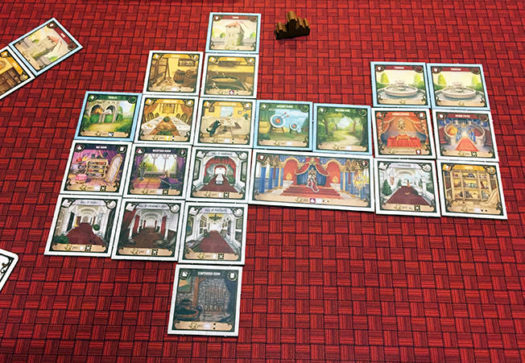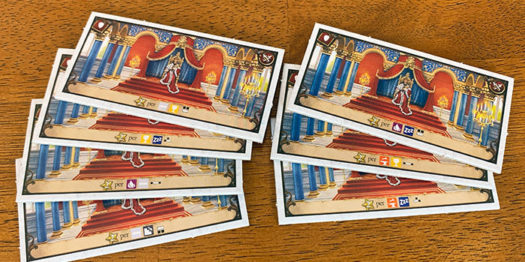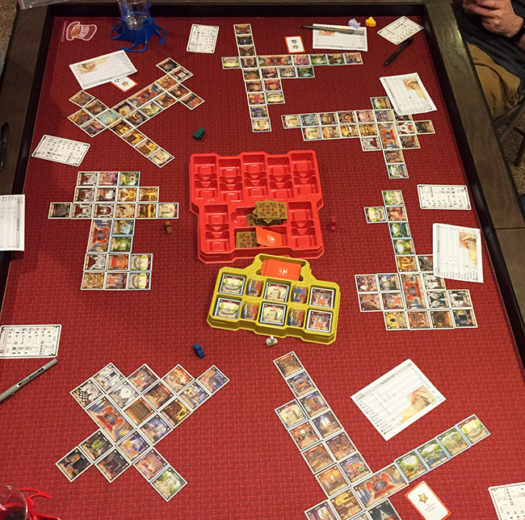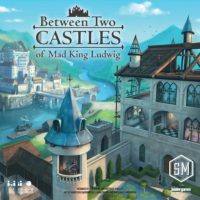Between Two Castles of Mad King Ludwig game review
You’re a world-renowned master builder who has been asked by Mad King Ludwig to help design his castles. Projects of such significance require the expertise of more than one person, so for each assignment you’re paired with another master builder to execute your grandiose plans.
Will your planning and collaborative skills be enough to design the most impressive castles in the world?”
Such is the introduction to the tile-laying, family board game, Between Two Castles of Mad King Ludwig, a collaborative production from Stonemaier Games and Bézier Games.
And what a fantastic collaborative production it is!

In 2016 we reviewed both Between Two Cities and Castles of Mad King Ludwig – both are terrific games. We love the crazy castles we get to build in Castles of Mad King Ludwig and love the collaborative city-building in Between Two Cities.
We also love how well Between Two Cities scales no matter the number of players. When we have 7 people ready to a play a game, Between Two Cities is a go-to game.
So when we heard about a mash-up of these two games, we were immediately on board to play it.
We weren’t quite sure how these two companies would pull it off. But since we’ve loved so many of their games, we were very hopeful.
And our hoping paid off well because Between Two Castles of Mad King Ludwig is a fantastic game!
How to play Between Two Castles of Mad King Ludwig
Between Two Castles of Mad King Ludwig is a tile-drafting game where each tile is a room in a castle. Similar to Between Two Cities, players work together with the players on their left and right to build something. But instead of joint cities, the players work to build joint castles out of the room tiles.
Each player will be building a castle to their left and right (between neighboring players). And each castle will be scored at the end of the game. A player’s final score will be the lowest score of their two castles. Then the player with the highest final score will be crowned the winner.

To begin, a random Throne room tile is placed between each player as well as a wooden castle marker. Each player is also given a helpful reference card to show how each room type may be placed and will score.
The game is played over 2 rounds.
At the start of each round, players draw a hand of 9 room tiles.

On each turn, players simultaneously choose two tiles from their hand to add to their castles. They place them face down in front of them until all players have chosen their tiles. The remaining hand of tiles are then passed to the next player.
Then all players reveal their 2 chosen tiles and determine which castle to place which room tile and where in the castles to place them. This is done in cooperation with the person to their left and right. Because each player must contribute 1 of their tiles to the castle on their left and 1 of their tiles to the castle on their right.

There are a few rule regarding tile/room placement in the castles. The reference cards show which rooms may be placed above ground level, which are placed below ground level, and which can be in either. Any tiles placed above the ground must be supported by the ground or another tile below. All tiles must be placed adjacent to an existing tile. Once placed, a tile cannot be moved.
Where players decide to place room tiles will depend on how they’ll score points. The reference cards also show how the rooms score.
- Food rooms: Shows another type of room that the Food room wants to be adjacent to. The Food room will score 2 points for each of those rooms adjacent to it.
- Living rooms: Shows another type of room that the Living room wants to be surrounded by. The Living room will score 1 point for each of those rooms surrounding it.
- Utility rooms: Shows another type of room that it wants to be connected to. The Utility room will score 1 point for each of those rooms in a connected chain.
- Outdoor rooms: Shows another type of room that it wants in the castle over all. The Outdoor room will score 1 point for each of those indicated rooms in the castle.
- Sleeping rooms: Each Sleeping room will score 4 points if the castle has all 6 other types of rooms anywhere in the castle. If the castle does not have at least one room of all 6 other types, it will only score 1 point.
- Corridor rooms: Shows a particular wall hanging that it wants to be surrounded by. The Corridor will score 1 point for each of those rooms surrounding it that has that type of wall hanging on it.
- Downstairs rooms: Shows another type of room that it wants above it. The Downstairs room will score 1 or 2 points for each of that type of room somewhere in the vertical column above it.
- Throne room: Each starting Throne room also shows 2 particular room types that it wants to be adjacent to in specific locations. It will score 2 points for each room type in the correct adjacent locations.

There are also special actions that occur when a castle has a 3rd room of each type added to it. Each room type gets a different bonus action for the 3rd room placement and those are also depicted on the reference cards. They include things such as adding more tiles, adding to the Throne room, and drawing Bonus point cards.

After the first Round ends, players take 9 more room tiles and begin the process again of drafting tiles to add to their castles. After selecting their 2 room tiles to place, they’ll pass their remaining tiles in the opposite direction from Round 1.
Once Round 2 ends, players total up the points of the castle to their left using the include score sheets. Once all castles have been scored, players compare the scores of the two castles on their left and right side. Their final score is the lower of their 2 castles.
The player with the highest final score is the winner!

Can the whole family enjoy Between Two Castles of Mad King Ludwig?
Between Two Castles of Mad King Ludwig is a fun game for players of most ages. The recommended age on the box is 10+. But if younger kids are playing with older kids or parents, they could have fun playing as well because of the semi-cooperative nature of the game.
There is a fair bit of thinking required in the game. But, since players work together with the player on both their left and right to build joint castles, there can be a little bit of hand-holding for younger players. And with experience, they’ll start to better understand the game and do well.
Of course, that could be said for all of us!

The first thing that will scare some people away is all the iconography. Just looking at the reference card may cause some people to decline playing because it looks like a lot to take in.
Yet, those reference cards are so helpful — not only in explaining the game, but also throughout the game as a reminder.
That being said, the tile themselves are pretty self-explanatory once players know where to look and digest the information on them.
The icons are pretty tiny on the tiles. But we’ve found that the size also draws players into looking at the details of each tile more closely. And they love doing so because the artwork detail on these 147 unique tiles is awesome!

Though they don’t have to, we’ve found it pretty common for players to announce which rooms they’ve added to their castle once they’ve placed it because they love both the artwork and the name of each room.
See for yourself by checking out the names of some of the rooms in the photos.
Another couple cool things to mention about the components are the Game Trayz inserts and the score sheets. The provided inserts are so slick! Not only do they keep all the tiles from sliding around in the box, they’re also sized so that 9 tiles are stacked in each compartment. And since players start each round with 9 tiles in their hand, it also makes starting a game a breeze.

In fact, shuffling the tiles back together and placing them randomly in the tray at the end of one game, you’re perfectly set up for the next game play.
And the score sheets make counting up points at the end of the game a breeze too. Simply go through each tile by type of room and record the score for that tile in the represented row. Then total them up and you’re done.
We also love how unlimited the game feels once you start building your castles.
You can build in any direction you want!
If you want to build a tall castle or a wide castle, that’s perfectly fine. And no matter how it plays out, it’s fun checking out everyone else’s castle to see what they came up with.

We also love that the game scales so well for a wide number of players. The game flows just as smoothly with 3 players as it does with 7.
That’s one of our favorite things about Between Two Cities, and it’s just as relevant with Between Two Castles of Mad King Ludwig.
When we’ve got 7 players wanting to play a game, the “Between Two” games and 7 Wonders are our top “go-to” games.

And of course we must mention the simultaneous play!
Games without much downtime on turns are always so welcome. And that’s so true here.
There may be a bit of waiting for some players to finalize their decisions on which 2 tiles to choose from their hand, but it’s very minimal. Mostly everyone makes their choices in about the same amount of time and play flows smoothly through both rounds.
Choose two tiles, discuss with your neighboring players, place them and choose again.
The only time it there’s a pause in the action is when players place a third tile of a particular room and get to take their bonus action. But that also goes fairly quickly.

To cap it all off, the way the winner is fantastic!
Players need to carefully balance the points between each of their castles to do well — because their final score will be the lowest of their two castles. So it won’t do any good to crank up the points on one castle at the expense of the other because they’ll be left with the lower scoring castle points in the end.
That balance and the fun of building crazy castles keep drawing us back for more.

How does Between Two Castles of Mad King Ludwig score on our “Let’s Play Again” game meter?
 If you haven’t guessed, Between Two Castles of Mad Kind Ludwig scores very high on our “let’s play again” game meter.
If you haven’t guessed, Between Two Castles of Mad Kind Ludwig scores very high on our “let’s play again” game meter.
For starters, we love tile-laying games. And the engaging artwork and thoughtful placement of each tile makes for fun choices every game. Plus, the simultaneous play works so smoothly that games seem to fly by. So there’s always a draw to play again right after one game ends.
And since it’s a game we can play with up to 7 people, it’s also always a game to have at the ready for game night.
Between Two Castles of Mad King Ludwig is a family board game we readily recommend.







I really like this game. Castles of Mad King Ludwig is in my top 10. I enjoyed Between Two Cities but wasn’t fully drawn in by it. When I played Between Two Castles, I came in with mixed expectations and came out really enjoying the game. I love the added bonuses and decisions that come after playing multiple rooms of the same type. I also felt the castle building theme a little more interesting than the city theme. The iconography is certainly tiny but functional and scoring can take a bit to grab hold of (similar to the original Between Two Cities) but it’s great and once you get a feel for it, there are tons of different strategies to pursue.
Thanks for another great review.
Chris – That’s a great story that shows expectations can be surpassed.